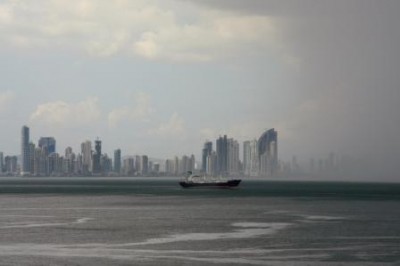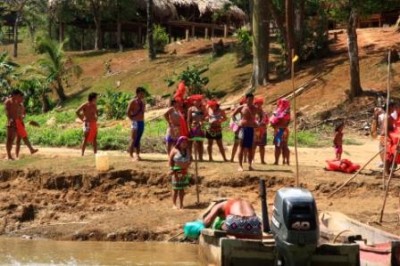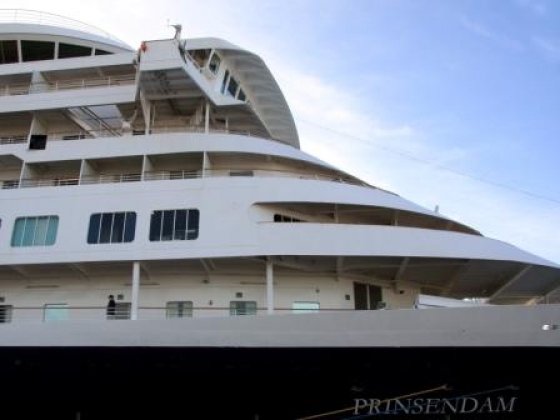Two days to go for Carnival, also in Panama. They are on a four day water throwing fest, de-inhibited by a liquid fest of sorts, beer being one of the sorts. The Prinsendam cannot dock in Panama City, as a matter of fact there are no commercial docking facilities. That would probably lead to a war anyway, with so many potential contenders for a limited number of piers. Then again, they are all in a hurry; as that was the raison-d’être of the canal in the first place.
I had signed up for a ride out to Indian territory. The canal, and the commerce that it has generated, has been overshadowing the other face of Panama: its pristine nature tracts. And to be sure, from our anchoring point, the skyscrapers of Panama City did not exactly provide any hint to the country’s real historical heritage either!
 Yet, there are still seven indigenous tribes living in the rain forests of Panama, five in the East and two in the West. The readers, who like me, see Panama as split by the canal in North (Costa Rica) and South (Colombia) parts, better think of North as West and of South as East, as the Panamanians do. The trip started off with a bus ride of one hour, along a highway which was in a better state than the sound system on the bus. To make matters worse it looked as if the hearing impaired were sitting in the back, such that the front sitters started complaining when the guide turned up the decibels. Switching places would obviously have been an effective solution, were it not for the fact that the less mobile were also in the back of the bus …
Yet, there are still seven indigenous tribes living in the rain forests of Panama, five in the East and two in the West. The readers, who like me, see Panama as split by the canal in North (Costa Rica) and South (Colombia) parts, better think of North as West and of South as East, as the Panamanians do. The trip started off with a bus ride of one hour, along a highway which was in a better state than the sound system on the bus. To make matters worse it looked as if the hearing impaired were sitting in the back, such that the front sitters started complaining when the guide turned up the decibels. Switching places would obviously have been an effective solution, were it not for the fact that the less mobile were also in the back of the bus …
We reached our destination without much more ado. The Indians hosts had come to meet us at the riverfront in traditional canoes. Although they were handcrafted they had left the paddles at home and used a powerful Suzuki outboard motor instead. Being narrow, relatively long and thus quite “mobile”, the boat balanced precariously around its longitudinal axis as it was being filled by the guests, many of them visibly unsure about their next step. Every boat took eighteen passengers, nine rows of two seats. Actually two “seats” was a one inch plank, across the full width, about one foot from the keel and probably three feet across at its widest. The embarkation was quite a spectacle to watch, judging by the many locals that had filled the landing area.
According to the brochure, we would reach the village after a thirty minute “glide” along the Rio Chagres. Not quite this time! To start with, the river turned out to give into a sizeable lake (many tens of square miles), which had been created when the canal was built (as drinking water reservoir). Its surface waters were not exactly flat either. Moreover, our “promoted paddler” ran out of gas, such that they had to organize a dynamic fill-up in the middle of the lake. It took almost an hour to reach the destination, but all in all a pleasant one! And time, well, time was not of the essence, not here and not then.
The village had organized a welcome party for the visitors on this Sunday morning: kids of all sizes, sexes and ages, a few young mothers and one older (wise?) man. All were dressed in traditional garb. In the case of the youngest kids that meant no garb. The novelty with this excursion was that it was organized by the Indians themselves: they made a conscious choice, in synch with the government, to complement their tribe’s income with tourism.
 Nowhere was there any hint that they had (to) put up a show. We could see where they live, we could take pictures (not in the private dwellings), they explained (in Spanish) what they do and how they do it (a standard 20ft canoe is two months of hard work for seven able bodies), we could buy their artifacts of course, and nobody was begging. Although the villages of the Embera are isolated, allowing them to continue to adhere to culture and language, they are certainly not living in the wild. It was all relaxed, pleasant and instructive. I was lucky to bump into a resident (Greek) anthropologist as well; he explained how democratic and socially caring they all are where it comes to tribal affairs.
Nowhere was there any hint that they had (to) put up a show. We could see where they live, we could take pictures (not in the private dwellings), they explained (in Spanish) what they do and how they do it (a standard 20ft canoe is two months of hard work for seven able bodies), we could buy their artifacts of course, and nobody was begging. Although the villages of the Embera are isolated, allowing them to continue to adhere to culture and language, they are certainly not living in the wild. It was all relaxed, pleasant and instructive. I was lucky to bump into a resident (Greek) anthropologist as well; he explained how democratic and socially caring they all are where it comes to tribal affairs.
We spent about three hours in the village, including a tasty lunch of freshly broiled tilapia with plantain, served in a rolled-up palm leaf, followed by pine-apple and water melon. Imbibed with this new cultural experience, we returned to the canoes (easier loading this time around) and sped off to the other world.
As soon as we reached the lake we got a telling answer to an earlier question: why had we all received an “emergency poncho” when we boarded in the morning? A stiff breeze had developed over the Chagres “Lake” and hit us in full face, just to the right of the bow. Heaps of water spray was blown straight into us. Some passengers (which I had silently judged to be a touch over-cautious for eventual rain showers) had donned the cape before we had left, others had not. Even though I managed to hold the plastic more or less in front of me, I got thoroughly drenched.
It was Panamanian Carnival after all!
Prinsendam, Day 63 – Tuesday March 8th, 2011
On our way to the last (but one) “destination”

